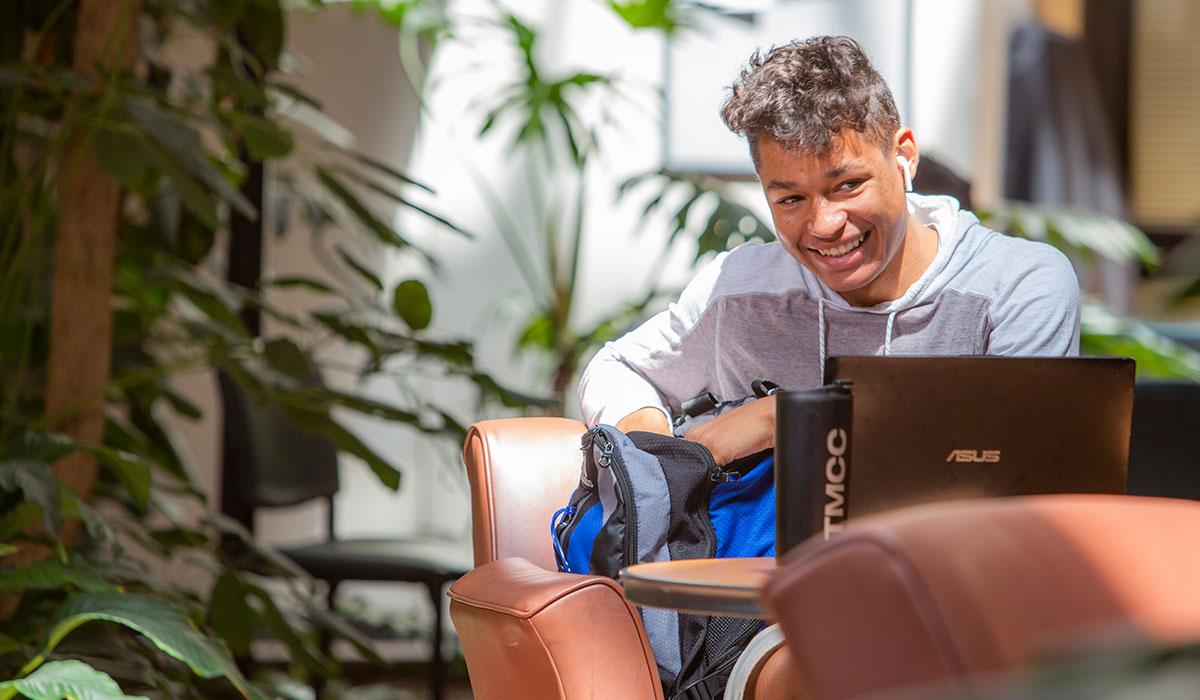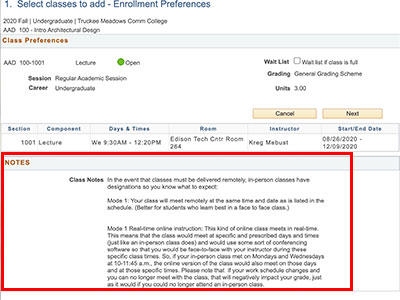
After spending half a semester taking online classes in every subject from Chemistry to yoga, we know the thought of returning to a virtual classroom probably makes your stomach turn over a little (and not in a good way.) However, we’re here to tell you that not all online classes are the same, and when you are registering for classes (even in-person ones)—reading the fine print on what you’re signing up for can help, in the case of another switch to remote learning. This information can be found in the “notes” section when you register for the class using MyTMCC.
While there will always be nuances between classes depending on the personality of the instructor, online classes come in two varieties: “real-time online instruction” and “similar to traditional online instruction.” We’ll get into the descriptions of each in the next section, but before we move on, you should definitely watch the introduction to WebCollege tutorial, and then read our Student Consent for taking online classes, because no matter what kind of online class you take, there are academic and behavioral expectations to which you will be held, as well as technical requirements. These links also offer information about online learning that you should be familiar with before you enroll in any kind of online class. Oh, and before we forget: if you are digging the online learning, we have wonderful news: TMCC offers entire degree programs you can earn online.
Take the Online Class Personality Quiz
If you like one option over another, guess what: we have a class that will suit you.
Question 1: Do you enjoy schedules and structures, and do you perform best when you are in the presence of others? If you answered “yes” to that question, chances are you are more likely to thrive in an online class that is taught using “real-time online instruction.” This means that the class would meet at the same day and time before the switch to remote learning happened. Additionally, the class would use some sort of conferencing software so that you would be “face-to-face” with your instructor and classmates during these specific class times. So, if your in-person class met on Mondays and Wednesdays at 10–11:45 a.m., the online version of the class would also meet on those days and at those specific times.
- The perks: The benefits of taking a real-time online class are many, but strictly speaking, it is the most like an in-person class that an online class can be. So, if you want to feel connected to your instructor and classmates—and to have the opportunity for real-time interaction—this class will keep a strict meeting schedule with face-to-face screen time sessions that can help to ease a sense of isolation.
- The pitfalls: There are specific challenges to keep in mind when choosing a real-time online class, however: you will have to make sure you have the technology and internet bandwidth to participate in online conferencing sessions that are a required part of the class. If your work schedule changes and you can no longer meet with the class, that will negatively impact your grade, just as it would if you could no longer attend an in-person class.
Question 2: Do you like to tackle your homework at random times, like 2 a.m. on a Thursday morning because of work and other obligations? If this sounds like your ideal version of an online class, a class that is conducted using the “similar to traditional online” mode might be right for you. In the case of a switch to remote learning, “similar to traditional online” classes will not have prescribed days and times to “meet.” Instead, the instructor has pre-recorded lectures, videos, and other class materials ahead of time.
- The perks: The benefits of a similar to traditional online class are many: students are able to move through the material at their own pace (although, please keep in mind that no matter what kind of online class you end up taking, there will always be assignment deadlines, exams, and other timely tasks.) If you work during the day, this kind of class would enable you to complete your homework and assignments when you have time available in the evening or early morning hours.
- The pitfalls: The challenges of taking a similar to traditional online class reside in the disconnection between you and your instructor and the other students in the class. Because all the material is recorded and produced beforehand, you aren’t interacting with anyone in “real-time.” While some students appreciate the ability to work on assignments at various moments during the day or night, if you like participating in real-time discussions with other students and your instructor, the “similar to online” instruction mode does not offer that kind of real-time interaction.
Let’s Hear from the Professionals
TMCC Political Science Professor Paul Davis, who has been teaching for TMCC for 45 years, believes there is a lot to like about similar to traditional online classes. Davis teaches Nevada Constitution (PSC 100) and American Constitutional Government (PSC 101) using this online format, and has received positive feedback from his students for years for his highly-organized course structure, his ability to respond and communicate with students as soon as they reach out to him and a hefty dose of good-natured humor and goodwill. “An online course reflects the personality and commitment of the professor,” he said.
More than that, though, Davis sees many positive aspects to structuring a class in this way. “[Similar to traditional online classes] allow students who may be shy in a traditional, [in-person] class setting to express their views in a positive and welcoming manner. It allows students to progress at the speed they feel comfortable. All of the assignments, quizzes, discussion posts, readings are posted on the first day of class. They may complete their classes in a couple of weeks (which is rare) or until the end of the semester. It allows the student to choose when and what method is best for them. One size does not fit all which is the way it is in a [in-person] setting,” he said.
Davis also admits that this mode of online instruction enables him to interact with students more readily. “I especially like teaching this way because it allows me to contact each student directly in a very personal method [...] I let them know that since I am half-cyborg I never sleep and respond to all of their communications immediately. This is absolutely essential in online teaching.” Since many of his students are also working part-time, and because the materials are readily available, students are able to complete the class in a way that works with their other obligations.
Yet, this kind of class requires a lot of the instructor who teaches it. “The organization of the class is paramount. There should not be any confusion about assignments,” said Davis.
TMCC Chemistry Professor Olga Katkova teaches General Chemistry (CHEM 121), a class that is typically taught in a traditional in-person classroom setting. However, due to the shift to remote learning during the Spring semester, her in-person class was instantly transformed into a similar-to-traditional online one. “I could not do real-time lectures because I ended up being a full-time stay-at-home mom to a toddler and working full-time [...] two things never meant to be together,” she said. She used YouTube resources along with her own pre-recorded lectures and materials to complete the semester. Her students remarked that the blending of both video resources was incredibly helpful.
Even though Katkova offered her students a similar to traditional online class, she made sure she stayed in contact with them on a frequent and regular basis, like Davis. “Every Monday, I provided instructions for the upcoming week so students could use it as a checklist. Every Friday, I sent out individual emails with the subject line of: ‘Are you doing OK?’ that asked them if there was anything I could do to assist them with finishing the semester… My students mentioned that these two emails were one of the most helpful things once we shifted to online instruction. I’m going to use this new approach (two emails weekly) into my upcoming fall classes even if we will be on campus and conducting face-to-face classes,” she said.
In case remote learning is implemented again in the Fall, however, Katkova said she is going to try real-time online instruction. “I believe real-time lectures work best for students. There is a lot of scientific data to support it as well. Students learn better during personal interactions (even if it is online),” she said. She also cites the ability to use conferencing technologies to split students into break rooms so they can brainstorm for the solutions during the active learning part of her lectures. “Plus, we can record these lectures just in case unexpected life events happen and [a] student cannot attend a lecture,” she said.
How Can I Tell What Kind of Online Class my In-Person Class Could Be?

The mode of online instruction that your class will use, should we move to remote learning again, can be found in the “Class Notes” section when you register for your class.
Now that you have an idea of what kind of online class would work the best for you, how can you tell if what you’re signing up for is what you actually want? When you register for classes, read the fine print (a.k.a.: the course notes underneath the table that lists the course location, time, instructor and start/end date.) In the “Notes” section, there will be a sentence indicating that, in the event that classes must be delivered remotely, the class will be taught either using a “real-time” method or a “similar to traditional online” method.
If you need clarification on the method of online instruction for your classes, contact the instructor or department directly, or contact the Admissions and Records Department at 775-673-7042. If you have questions about whether a class fulfills your degree requirements, schedule an appointment with one of our academic advisors by calling 775-673-7062.






